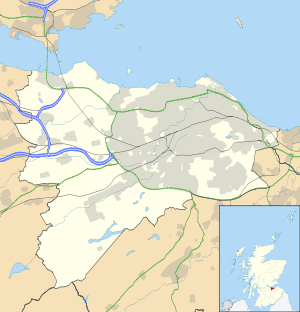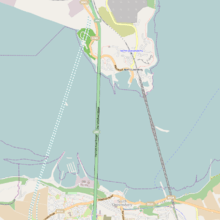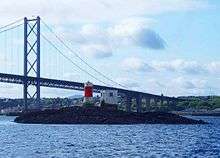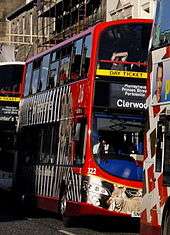Queensferry Crossing
- This article is about a bridge in Scotland. There is also a main-road bridge at Queensferry, Flintshire in Wales. For the road bridge currently in use, see Forth Road Bridge.
| Queensferry Crossing | |
|---|---|
 Artist's impression of the Queensferry Crossing (left) alongside the Forth Road Bridge (centre) and the Forth Bridge (right) | |
| Coordinates | 56°00′17″N 3°24′45″W / 56.0046°N 3.4124°WCoordinates: 56°00′17″N 3°24′45″W / 56.0046°N 3.4124°W |
| Crosses | Firth of Forth |
| Locale | Lothian and Fife, Scotland |
| Characteristics | |
| Design | Cable-stayed bridge |
| Total length | 2,700 metres (8,858 ft) |
| Width | Dual two-lane carriageway with hard shoulders[1] |
| Longest span | 650 metres (2,133 ft) |
| History | |
| Constructed by | Forth Crossing Bridge Constructors (FCBC) |
| Construction begin | September 2011 |
| Construction end | May 2017 (projected) |
| Construction cost | £1.35 billion (estimated) |
 Queensferry Crossing Location of the bridge in relation to Edinburgh | |
The Queensferry Crossing (formerly the Forth Replacement Crossing) is a road bridge under construction in Scotland. It is being built alongside the existing Forth Road Bridge and will carry the M90 motorway across the Firth of Forth between Lothian, at South Queensferry, and Fife, at North Queensferry.
Proposals for a second Forth road crossing were first put forward in the 1990s, but it was not until the discovery of structural issues with the Forth Road Bridge in 2005 that plans were moved forward. The decision to proceed with a replacement bridge was taken at the end of 2007; the following year it was announced that the existing bridge would be retained as a public transport link. The Forth Crossing Act received Royal Assent in January 2011, and construction began in September 2011.
The Queensferry Crossing will be a cable-stayed bridge, with an overall length of 2.7 kilometres (1.7 miles).[2] Around 4 kilometres (2.5 miles) of new connecting roads will be built,[3] including new and upgraded junctions at Ferrytoll in Fife, South Queensferry and Junction 1A on the M9. It will be the third bridge across the Forth at Queensferry, alongside the Forth Road Bridge completed in 1964, and the Forth Bridge completed in 1890. The bridge was due to be completed by December 2016, however that date has been put back to May 2017 due to weather delays slowing construction,[4] with 25 days lost due to high winds during April and May 2016.[5] Following a public vote, it was formally named on 26 June 2013.
Background to the project
The Forth Road Bridge opened in 1964, replacing a centuries-old ferry crossing. Proposals for an additional road crossing at Queensferry were drawn up in the early 1990s, as part of the "Setting Forth" consultation document prepared by the Scottish Office.[6] The plans met stiff opposition from environmentalists and from the City of Edinburgh Council on the grounds of the increased traffic. Following the Labour victory in the 1997 general election, the proposals were shelved.[7]

The existing bridge had a planned design life of 120 years,[8] but by the early years of the 21st century the planned theoretical capacity for the bridge was being routinely exceeded. It was designed for up to 11 million vehicles per year, but this had risen steadily to 23 million vehicles in 2006.[9] Between 2003 and 2005, an inspection programme found that the main suspension cables had suffered an estimated 8–10% loss of strength as a result of corrosion. Projections highlighted the likelihood of an accelerating loss of strength, with traffic restrictions to limit loading required in 2014 in the worst-case scenario.[10]
The strategic transport importance of the road bridge – and the threat of closure by 2019 if major structural work was not successful – led to fears of serious economic consequences, especially as work on a new crossing was estimated to take up to 11 years.[11] Scottish Transport Minister Nicol Stephen commissioned a new study, which priced a second Forth Road Bridge at £300 million, in 2003.[7] The Forth Estuary Transport Authority voiced support for a new bridge in 2005,[12] and in 2006 the UK Transport Secretary, Alistair Darling, spoke in favour of the idea.[13]
Planning
In 2007, the Forth Replacement Crossing Study was commissioned by Transport Scotland to examine various options for new bridges or tunnels across the Forth. The report recommended adoption of a cable-stayed bridge, located to the west of the Forth Road Bridge, as the preferred solution. The study concluded that this option was significantly cheaper than a tunnel, would take less time to construct, and would represent better value for money, though it was noted that a tunnel would have fewer environmental impacts.[14] In December 2007 finance secretary John Swinney announced that a new cable-stayed bridge would be constructed, with an estimated cost of between £3.25 billion and £4.22 billion. He claimed it would be "the largest construction project in a generation in Scotland".[15]
There was opposition to the project on environmental, traffic and cost grounds. The ForthRight Alliance, an umbrella group including Friends of the Earth, the Scottish Green Party, the RSPB, sustainable transport groups and other local organisations, opposed the scheme as being "both unwelcome and unnecessary".[16] Another group, Forth Tunnel Action Group, campaigned for a tunnel as the solution with lowest costs and fewest long-term environmental impacts.[17]
It was initially suggested that the new bridge would be funded via the Scottish Futures Trust, an alternative to public-private partnership funding for major public-sector schemes. However, the Scottish Government announced in December 2008 that public funding would be used.[18] As part of the Scottish Government's Strategic Transport Projects Review, the new Forth crossing was priced at between £1.72 billion and £2.34 billion.[19] Under the revised scheme, the existing bridge will be retained for public transport, cyclists and pedestrians, and the new bridge will be operational by 2016.[18]
A joint venture between consultancies Arup and Jacobs was appointed as project manager, and in February 2008 environmental and technical studies were begun, continuing through 2009. Public consultations were held, and some changes to the scheme were made in response to the comments received.[20] An environmental statement was published in November 2009,[21] coinciding with the introduction of the Forth Crossing Bill into the Scottish Parliament by John Swinney. A majority of MSPs voted in favour of the new legislation on 16 December 2010,[22] and the Forth Crossing Act received Royal Assent in January 2011.[23]
Bidding process
In 2009, Transport Scotland solicited for tenders to construct the proposed bridge.[24] Although Transport Scotland received 39 expressions of interest, concerns over the risks associated with the fixed-price contract resulted in only two consortia of large construction companies bidding.[25] Due to the bidders' concerns that the bidding process itself would prove to be an expensive proposition, the Scottish Government allocated £10 million to defray the bidders' costs during the full bidding process, should the project be abandoned.[25]
The two consortia were Forthspan, which included Morgan Sindall, BAM Nuttall and Balfour Beatty; and Forth Crossing Bridge Constructors (FCBC), which consists of Dragados, Hochtief, American Bridge, and Morrison Construction.[26] Bids for the main contract, priced at between £900m and £1.2bn, and including design and construction of the bridge and approach roads,[26] were submitted in January 2011.[24] In March 2011 the Scottish Government announced FCBC as preferred bidder, with a bid of £790 million.[27][28]
In addition to the main contract, two smaller contracts form part of the scheme. The contract to implement the Intelligent Transport System (ITS) traffic management system in Fife was awarded to John Graham (Dromore) Ltd, with a tender of £12.9 million, while the upgrade of M9 Junction 1a was awarded to a joint venture between John Sisk and Roadbridge, with a tender of £25.6 million. As with the main contract, the tenders received were below the original estimated budgets.[29][30]
Construction

Preparatory works for the new bridge began in September 2011 with works beginning at the southern end of the M90 to build the northern approach roads. Construction works are scheduled to take around five and a half years, and the bridge is currently scheduled to open in May 2017 (delayed from December 2016 after delays due to strong winds).[4] 149 segments of bridge deck, each of which is 12 metres (39 ft) long and 40 metres (130 ft) wide, were constructed in China and Spain, then delivered by sea in October 2013.[31] The approach steel bridge sections were manufactured by Cleveland Bridge UK in Darlington.[32]
The towers reached 160 metres in height in August 2015, making it the UK's tallest bridge.[33] When complete these towers will stand at 200 metres.[33]
On 28 April 2016 one construction worker was killed and another injured in an accident involving a crane. Work on the bridge was halted to allow an investigation to take place.[34][35]
The bridge


The new bridge will be a cable-stayed structure, with three towers each 207 metres (679 ft) high.[31] Including approaches, the overall length of the bridge will be 2.7 kilometres (1.7 miles). The bridge will carry two lanes of traffic in each direction, plus hard shoulders, with the road designed to motorway standard. The new bridge will carry motor-cycles, cars and heavy goods vehicles, while public transport, cyclists and pedestrians will use the existing bridge. Wind shielding will be built into the design, to enable use of the bridge in high winds, which regularly led to restrictions on the existing bridge.[1]
The bridge will be the third crossing of the Forth at Queensferry, alongside the Forth Road Bridge, completed in 1964, and the Forth Bridge, a railway bridge completed in 1890. It will be sited west of the road bridge, with the northern landfall at St Margaret's Hope, between Rosyth Dockyard and North Queensferry and the southern landfall just west of Port Edgar in South Queensferry. The central tower is constructed on the Beamer Rock, a small islet in the Forth. The project was known as the Forth Replacement Crossing, and a name for the new bridge was selected in a public vote in 2013 after a panel of independent advisers provided a shortlist of possible names.[36][37] A short-list of five names were selected, these were Caledonia Bridge, Firth of Forth Crossing, Queensferry Crossing, Saltire Crossing and St Margaret's Crossing. A public vote was held up until 7 June 2013 and the Queensferry Crossing name received the most votes, with 12,039 (of 37,000) votes in a public poll.[38][39]
Connecting roads
Several new and upgraded roads will connect the bridge into the existing road network with around 4 kilometres (2.5 miles) of new roads to be constructed. These new roads will join the M9 and M90 motorways together for the first time, with the Queensferry Crossing being built to motorway standard in order to carry the M90 across the Forth. The current M90 motorway terminates at Admiralty Junction, around 3 kilometres (1.9 miles) north of the current Forth Road Bridge, with the road continuing as dual carriageway across the existing bridge and joining the M9 via the M9 Spur.[40][41]
Admiralty Junction
Admiralty Junction, the present Junction 1 of the M90 motorway will be unaltered, with the exception of a bus lane to be added on the southbound carriageway. The junction will be renumbered to Junction 1C of the M90 when the Queensferry Crossing opens.[41]
Ferrytoll Junction
Ferrytoll Junction will be redesigned to give access to the new crossing and to maintain public transport access to the Forth Road Bridge. The design of the new junction requires the realignment of the B981 road to North Queensferry.[42] Ferrytoll Junction will be numbered Junction 1B of the M90 following completion of the Queensferry Crossing.[41]
South Queensferry Junction
The M90 will be extended west from the current bridge access at Ferry Muir, wrapping around South Queensferry to the southern landfall of the new crossing. A grade-separated junction will be built on the A904 just west of Echline, at the south-west edge. The existing access from the Forth Road Bridge to the A90 will remain open to public transport.[43] South Queensferry Junction will become Junction 1A of the M90 when the Queensferry Crossing opens.[41]
M9 Junction 1a
Junction 1a provides access from the M9 to the Forth Road Bridge via the M9 Spur. Originally, only east-facing connections were provided to the M9, forcing traffic heading west from the bridge onto the A904 through the village of Newton in West Lothian. The upgrade of the junction included new west-facing slip roads, enabling direct access onto the M9 from the Forth Road Bridge and the new crossing, as well as widening of the existing connections to assist the flow of traffic at peak times.[44] The improvements were completed in February 2013 at a cost of £25.6m.[45] The M9 Spur will become the M90 upon completion of the Queensferry Crossing, the junction connecting the A90 coming from the Forth Road Bridge with the A90 towards Edinburgh city centre and the M9 Spur will be named the Scotstoun Junction and will be numbered as Junction 1 of the M90.[41]
Intelligent Transport System
An "Intelligent Transport System" (ITS) will be installed between Halbeath on the M90, and the M9, covering the whole scheme. The ITS is a traffic management system, enabling variable speed restrictions and lane closures to be displayed on overhead gantries.[41]
Archaeological finds
During routine archaeological excavations in advance of work on the new Queensferry Crossing remnants of a mesolithic era dwelling was found on the south bank of the Forth. The dwelling, based around an oval pit approximately 7 metres (23 ft) in length, has been dated to around 8240 BC, making it the earliest known dwelling in Scotland.[46]
References
- 1 2 "The new bridge". Transport Scotland. Retrieved 14 May 2012.
- ↑ "Transport Scotland The Queensferry Crossing". Transport Scotland. 2014. Retrieved 22 February 2014.
- ↑ "Transport Scotland The Queensferry Crossing". Transport Scotland. 2014. Retrieved 22 February 2014.
- 1 2 "New Queensferry Crossing opening delayed until May 2017". BBC News. 8 June 2016. Retrieved 8 June 2016.
- ↑ Morby, Aaron (9 June 2016). "Queensferry Crossing to open five months late". Construction Enquirer. Retrieved 9 June 2016.
- ↑ "Setting Forth: a consultation document on the Firth of Forths transport links". TRID. Transportation Research Board. Retrieved 3 May 2012.
- 1 2 "£300m price tag put on bridge to beat gridlock". scotsman.com. 6 June 2004.
- ↑ "FAQs". Forth Estuary Transport Authority. Retrieved 3 May 2012.
- ↑ "Firms told time running out on Forth Road Bridge". The Scotsman. 7 October 2006.
- ↑ Barry R Colford & Charles P E Cocksedge (2006). "Forth Road Bridge – First internal inspection, strength evaluation, acoustic monitoring and dehumidification of the main cables" (PDF).
- ↑ "Time running out for new bridge – News". scotsman.com. 2006-01-26.
- ↑ "Vote favours 'new Forth Bridge'". BBC News. 29 April 2005.
- ↑ "Minister defiant on bridge issues". BBC News. 26 January 2006.
- ↑ Jacobs (June 2007). "Forth Replacement Crossing Study Report 5 : Final Report Non Technical Summary" (PDF). Transport Scotland. pp. 16–17.
- ↑ "Forth to get new iconic bridge – News". scotsman.com. 2007-12-19. Retrieved 2012-01-15.
- ↑ "The ForthRight Alliance". ForthRight Alliance. Retrieved 3 May 2012.
- ↑ "Our Objectives". Forth Tunnel Action Group. Retrieved 3 May 2012.
- 1 2 "Cut-price Forth crossing outlined". BBC News. 10 December 2008.
- ↑ "Transport blueprint at-a-glance". BBC News. 10 December 2008.
- ↑ "Public helps shape Forth Replacement Bridge Project". Transport Scotland. 23 June 2009.
- ↑ "Forth Replacement Crossing: Environmental Statement". Transport Scotland. 17 November 2009.
- ↑ "BBC News – New Forth bridge plans approved by MSPs". bbc.co.uk. 2010-12-15. Retrieved 2012-01-15.
- ↑ "Royal Assent granted for Forth Replacement Crossing". Transport Scotland. 21 January 2011.
- 1 2 "Principal contract". Transport Scotland. Retrieved 2012-01-15.
- 1 2 "Just two bidders to build new Forth bridge". Scotsman.com. 29 September 2009.
- 1 2 "Construction industry invited to bid for Forth Replacement Crossing contract" (Press release). Transport Scotland. 30 November 2009. Retrieved 1 December 2016.
- ↑ "Consortium to build new Forth bridge". BBC News. 21 March 2011.
- ↑ "Preferred bidder announced for Forth Replacement Crossing" (Press release). Forth Estuary Transport Authority. 21 March 2011. Archived from the original on 14 March 2012.
- ↑ "Another major contract award for Forth Replacement Crossing scheme" (Press release). Transport Scotland. 10 June 2011.
- ↑ "More savings, more jobs announced on Forth Replacement Crossing" (Press release). Transport Scotland. 30 June 2011. Retrieved 1 December 2016.
- 1 2 "Forth Bridge may be finished a year early (if Scottish weather allows)". The Scotsman. 17 March 2012.
- ↑ "No Scots Bids for Forth Bridge Contract". The National. 21 October 2015.
- 1 2 "Queensferry Crossing becomes UK's tallest bridge". BBC News. 13 August 2015.
- ↑ "Worker killed in incident on Queensferry Crossing". British Broadcasting Corporation. 29 April 2016. Retrieved 30 April 2016.
- ↑ "Tragedy occurs on Workers' Memorial Day". Union of Construction, Allied Trades, and Technicians (UCATT). 28 April 2016. Retrieved 30 April 2016.
- ↑ "Transport Minister Announces Naming Process for New Forth Crossing". Transport Scotland. 6 March 2012.
- ↑ "Public to be involved in naming of new bridge". Transport Scotland. 22 March 2011.
- ↑ "Name the bridge". Transport Scotland. Retrieved 29 April 2013.
- ↑ "New Forth bridge: Queensferry Crossing wins naming contest". BBC News. 26 June 2013.
- ↑ "Connecting road network". Transport Scotland. Retrieved 14 May 2012.
- 1 2 3 4 5 6 Transport Scotland. "Intelligent Transport Systems - Transport Scotland". Scottish Government. Retrieved 2013-07-09.
- ↑ "Ferrytoll Junction". Transport Scotland. Retrieved 14 May 2012.
- ↑ "South Queensferry Junction". Transport Scotland. Retrieved 14 May 2012.
- ↑ "M9 Junction 1a". Transport Scotland. Retrieved 14 May 2012.
- ↑ "FRC junction opens early and under budget". Transport Scotland. Retrieved 24 July 2013.
- ↑ Cowing, Emma (18 November 2012). "Archaeologists unearth Stone Age dwelling on the banks of the new Forth crossing". The Scotsman.
External links
| Wikimedia Commons has media related to Queensferry Crossing. |
- Forth Replacement Crossing, Transport Scotland
- Financial Scrutiny Unit Briefing: The Forth Replacement Crossing First Principles, Scottish Parliament Information Centre (SPICe) Briefing
- New Forth Bridge construction blog, New Forth Bridge construction blog


